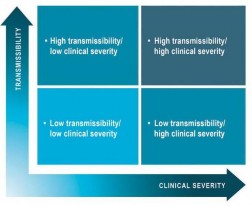As the World Health Organization (WHO) continues to raise awareness of the coronavirus (abbreviated as COVID-19) epidemic, it is important to assess the level of potential impact this epidemic may have on your business, potentially based on:

- The official declaration of a pandemic
- An increased number of employees who become ill and are unable to report to work
- Other employees who are at higher level of exposure and are quarantined for certain periods
- Business partners and critical vendors which may become compromised due to this illness
There are many considerations in planning to mitigate the overall risk in any of these scenarios. These articles outline some specifics:
Based on this recent threat, your company’s business continuity planning should be reviewed and, if necessary, refreshed. A great resource for this exercise is the Ontario Pandemic Influenza Plan for Continuity of Electricity Operations.
Pandemic planning builds on typical Business Continuity planning that focuses on site-specific or area-specific natural and man-made hazards (fires, severe weather etc.) and adds additional planning actions related to:
- Social distancing policies - staying away from fellow employees and physical separation
- Personal hygiene practices - washing hands, sanitizing, coughing into sleeve
- Personal protective equipment (PPE) - masks or gowns, depending upon situation
- Special employee absence and compensation policies - extended sick leave policies, special family leave
Your Business Continuity Plan should include a crisis-specific action plan that focuses on high absentee rates and potential fatalities. When planning, it is recommended to use a range of assumptions that would recognize peak absenteeism as follows. Each of these ranges correspond to the attack rates of 15%, 25% and 35% respectively described in the Ontario Health Provincial Pandemic Plan.1
- 20% absenteeism for one week, 10% for the remainder of the wave
- 30% absenteeism for one week, 15% for the remainder of the wave
- 40% absenteeism for one week, 20% for the remainder of the wave
For each of these ranges, LDCs need to consider their essential operations and identify the means to eliminate or reduce the impact of reduced staffing levels. While a pandemic may occur in multiple waves, this range of assumptions is expected to be appropriate for any one of the waves.
It is also important to stay informed and to focus on official sources of information on the development of this epidemic, such as:
World Health Organization
Public Health Agency of Canada
Public Health Ontario
Centers for Disease Control and Prevention
In developing your specific response plan the following should be considered:
Assessment of the Expected Impact
-
-
Which operations could be suspended, if required?
-
Plans to function with a skeleton staff, if needed
-
Back-up plans to maintain critical communications and technology services
-
Employee absence policies
-
Education for employees on hygiene habit
Evaluation of the Risk Level: How do your employees get to work? Can employees work from home? Do you share facilities with other companies? Do you have multiple locations from which mission critical operations can take place? Do you have shared support for control rooms with neighboring LDCs?
Action Levels:
Level 1 – monitor and prepare, you know the event is coming, be prepared
Level 2 – implementation of social distancing policies and PPE requirements, to keep the organization open
Level 3 – close your facilities and work from a safe, remote location or from home
Currently the COVID-19 has been categorized as an epidemic, which is a more localized outbreak that affects a facility, city or region. Recent trends suggest it may become a pandemic, which is an epidemic that becomes very widespread and affects a whole region, a continent, or the world due to a susceptible population.2 A pandemic or epidemic may present serious issues for your staff but by planning ahead you can minimize the potential disruption to your operations.
This Reciprocal Newsletter is an electronic publication intended for Subscribers of The MEARIE Group’s Insurance programs. It is published on a periodic basis and intended for information purposes only. In the event of specific claims, incidents or legal actions against the Subscriber, coverage will be determined by MEARIE policy interpretation.
|